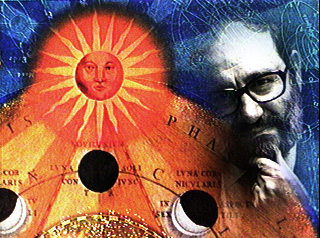Writing, Briefly
April 25th, 2005Paul Graham’s essay on Writing, Briefly took just over an hour to write – and two thirds of that was spent re-writing. I learned about anaphora.
Paul Graham’s essay on Writing, Briefly took just over an hour to write – and two thirds of that was spent re-writing. I learned about anaphora.
rLogo is a Java based implementation of the Logo programming language. I used a simple ‘starter’ in a recent Maths lesson where students had to learn about the exterior and interior angles of a polygon and learn to solve problems along the lines of ‘can a regular polygon have an interior angle of 125 degrees?’.
On paper, I had the following questions / tasks…
Challenges included
After some pairs work and some ‘walking through’ solutions (a rare use of ‘kinetic intelligence’ in Maths) I introduced the Logo primitives for forward and right turn, and used the rLogo tutorial page on a projector to draw solutions. I mentioned the ‘repeat 4 [fd 100 rt 90] approach as well. Finally, I suggested that crop circles might be drawn the same way…
It all seems to have stuck but it will come as no suprise that people had problems setting up and solving the equation to show that a regular polygon can’t have an interior angle of 125 degrees…

If you need to find out about a star constellation then Richard Dibbon-Smith’s Web site about The Constellations is what you need. The table is sorted alphabetically and includes all 88 constellations (personally, I would have grouped them by Northern and Southern hemisphere with a generous overlap but who is arguing?)
Richard sells a couple of small format (A6) books based on the information in the Web site and I have both. The Constellations Pocket Guide is a ‘perfect’ bound (i.e. pages glued together like most paperback books) 298 page tome measuring about three-quarters of an inch thick. It fits into a spare pouch in a rucksack. Each constellation has a couple of pages and a map with the naked eye stars and descriptions of notable objects and a re-telling of the myth, a sort of Coles Notes guide to the Greek mind that is more useful than you might imagine.
The Binocular (and Naked eye) Guide to the Stars is a spiral bound A6 format book again with all the constellations listed alphabetically but without as much detail on the mythology. Instead the space is filled with descriptions of notable stars, clusters and other objects in each constellation with particular mention of the variable stars that can be seen easily with the unaided eye or binoculars. Constellation maps covering 30 to 50 degrees of sky are not provided, instead you get representations of parts of the constellation as seen through binoculars with a field of 7.5 degrees – very handy under a dark sky, also useful for many telescope finders. Objects that can be seen effectively only with optical aid have a cute binocular icon printed next to them. Constellations in this shorter book start part way down a page in some cases – this makes it harder to vandalise the book to include only the relevant constellations!
The Web site provides quantities of information for free access, and self-published books are available for a small charge, and this to me shows how the Web can facilitate self-publishing.
Tinderbox is a note taking application for Mac OS X. A Windows version is in the works – in fact the author Mark Bernstein’s blog includes a link to his development peekhole for Tinderbox.
Tinderbox has a range of powerful features for organising and visualising relationships between notes – such that I am going to try using it as a presentation tool soon. Notes can contain notes, and notes can link to notes. The program stores information in XML format files – including images copied from the Preview application. The program is small and fast – memory use appears to be the size of the XML file plus about 5 Mb.
Tinderbox includes a very flexible HTML export with templating available on a per-file basis and on classes or categories of notes within a file. Imagine a collection of hypertext pages such as Rice University’s Galileo Project documents. Here there is a lot of information organised under various headings, but the pages cross link accross the headings. A given page deep in the project would have pages above it in a given category, but would also make links across to pages in other categories. It might also be useful to show what pages link to the page in question to allow the reader to explore the rich context.
Below (displayed in the text editor mi) is the mark up for a bare bones HTML export template that will automatically generate the page links from a Tinderbox file.

This template does not use the more powerful features of Tinderbox such as Prototype notes and Agents but as Mark Bernstein remarks in a post on the Tinderbox wiki, it is best to start small and simple.
There are a couple of reviews of Tinderbox on the Web – most of these focus on blogging. I’m interested in a richer use of this program to manage a topic based project with full cross linking. A wiki could handle the cross linking but the linking would be embedded in the text: I like the way Tinderbox can establish links between notes as a whole so that links on the resulting Web pages can be organised under headings so as not to distract the reader. Tinderbox can provide links in the text, and these may be more appropriate for non-instructional hypertexts.
Watch out for a set of pages on statistics at about level 3. The bodmas blog will stay server side as I need to update from various computers.

The starting square has side 1. Another side 1 square appears, and then a side 2 square is added across the top of them. Then a square of side 3 appears to the left, and a sqare of side 5 appears underneath.
The sequence of the sides of the squares is like this…
1, 1, 2, 3, 5,...
and that is the Fibonacci series! The next term is obtained by adding the two previous terms.
If you reproduce the construction on some graph paper you can make a spiral curve through the squares – the kind of spiral you get is called the equiangular spiral or the logarithmic spiral.
The equiangular bit comes from the property that at any point on the spiral, a line drawn from the point to the centre of the spiral will make the same angle to the path of the spiral. In the case of the spiral generated from the square construction above, that angle will by 90¬?. If you used a rectangle as the starting shape, you could change the angle… How would the ratio of the sides of the rectangle change the angle of the spiral?

“The fact is that the world is divided between users of the Macintosh computer and users of MS-DOS compatible computers. I am firmly of the opinion that the Macintosh is Catholic and that DOS is Protestant. Indeed, the Macintosh is counterreformist and has been influenced by the “ratio studiorum” of the Jesuits. It is cheerful, friendly, conciliatory, it tells the faithful how they must proceed step by step to reach – if not the Kingdom of Heaven – the moment in which their document is printed. It is catechistic: the essence of revelation is dealt with via simple formulae and sumptuous icons. Everyone has a right to salvation.DOS is Protestant, or even Calvinistic. It allows free interpretation of scripture, demands difficult personal decisions, imposes a subtle hermeneutics upon the user, and takes for granted the idea that not all can reach salvation. To make the system work you need to interpret the program yourself: a long way from the baroque community of revelers, the user is closed within the loneliness of his own inner torment.
You may object that, with the passage to Windows, the DOS universe has come to resemble more closely the counterreformist tolerance of the Macintosh. It’s true: Windows represents an Anglican-style schism, big ceremonies in the cathedral, but there is always the possibility of a return to DOS to change things in accordance with bizarre decisions…..
And machine code, which lies beneath both systems (or environments, if you prefer)? Ah, that is to do with the Old Testament, and is Talmudic and cabalistic.”
—UmbertoEco Sept 30 1994, quoted in La bustina di Minerva, in the Italian news weekly Espresso, September 30, 1994
I found this reference from an article in the BBC News Technology Web site by Stephen Evans variously entitled The Cult of the Mac and/or Apple a day keeps the music at play. Its all about the iPod thing but dredges up the Eco quote.
Eco was writing some years ago (only 10 years but a geological age in Computer terms) and things have changed. I wonder how Eco would characterise my iBook? Still the ‘cheerful, friendly, conciliatory’ front end but now the nuclear powered Terminal with a faint sulfurous wiff from the Unix command line (Mephistopheles like, the command line can show hidden rooms and bring on powerful agents and even control daemons…).
There is ‘something of the night’ about how you can be dragging files to icons one minute and piping a Web page from curl to sed to strip the html codes the next. A meeting of the faiths if ever there was one!